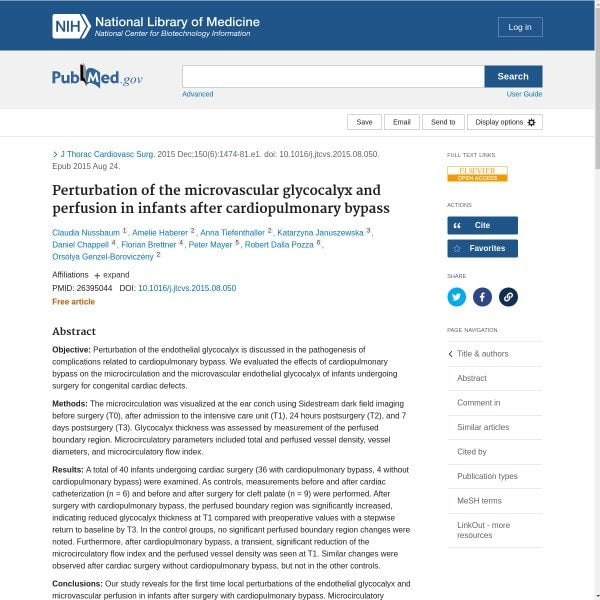
Perturbation of the microvascular glycocalyx and perfusion in infants after cardiopulmonary bypass
Share

Abstract
Objective: Perturbation of the endothelial glycocalyx is discussed in the pathogenesis of complications related to cardiopulmonary bypass. We evaluated the effects of cardiopulmonary bypass on the microcirculation and the microvascular endothelial glycocalyx of infants undergoing surgery for congenital cardiac defects.
Methods: The microcirculation was visualized at the ear conch using Sidestream dark field imaging before surgery (T0), after admission to the intensive care unit (T1), 24 hours postsurgery (T2), and 7 days postsurgery (T3). Glycocalyx thickness was assessed by measurement of the perfused boundary region. Microcirculatory parameters included total and perfused vessel density, vessel diameters, and microcirculatory flow index.
Results: A total of 40 infants undergoing cardiac surgery (36 with cardiopulmonary bypass, 4 without cardiopulmonary bypass) were examined. As controls, measurements before and after cardiac catheterization (n = 6) and before and after surgery for cleft palate (n = 9) were performed. After surgery with cardiopulmonary bypass, the perfused boundary region was significantly increased, indicating reduced glycocalyx thickness at T1 compared with preoperative values with a stepwise return to baseline by T3. In the control groups, no significant perfused boundary region changes were noted. Furthermore, after cardiopulmonary bypass, a transient, significant reduction of the microcirculatory flow index and the perfused vessel density was seen at T1. Similar changes were observed after cardiac surgery without cardiopulmonary bypass, but not in the other controls.
Conclusions: Our study reveals for the first time local perturbations of the endothelial glycocalyx and microvascular perfusion in infants after surgery with cardiopulmonary bypass. Microcirculatory monitoring might be a useful tool to evaluate interventions aiming at reduction of bypass-related complications.
